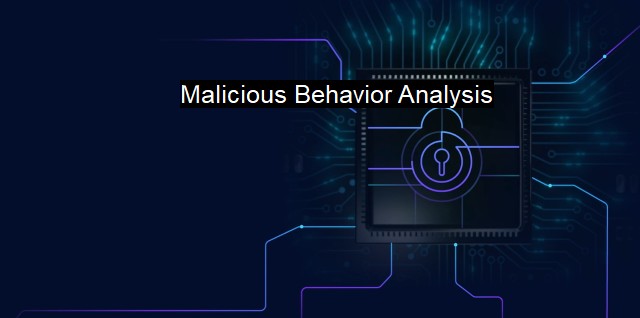What are Malicious Behavior Analysis?
Understanding Malware: The Importance of Malicious Behavior Analysis in Cybersecurity
Malicious Behavior Analysis, in the context of cybersecurity and antivirus software, is the process by which software, systems, or personnel analyze and behave in response to potentially harmful or destructive actions within a network or system. The focus is on identifying and tracking activities that may compromise the properties of security systems. It includes actions such as the spreading of viruses, worms, unauthorized usage of systems or data, and denial of service, amongst others. An essential aspect of maintaining the integrity and security of systems in the face of increasing cyber threats involves understanding, anticipating, and responding to such behavior.Malicious Behavior Analysis primarily deals with the monitoring and tracking of any potential threats that could compromise or harm a system. Users or system administrators often employ this process, alongside robust antivirus software. At its core, the goal is to ensure the confidentiality, integrity, and availability of systems or data is not compromised. Often, this entails close collaboration between people, processes, and technologies in concert.
Behavior Analysis tools begin by establishing what constitutes typical system behavior. By doing this, they can better detect any deviations or anomalies from the norm which might denote malicious activities. They perform a deep-inspection of files, network traffic, and system processes using heuristics - rules that help identify suspicious behavior.
One of the key components in malicious behavior analysis involves identifying potential threats through signs of irregular, unexpected or out-of-place behavior. email attachments containing unusual files, increases in network traffic, or suspicious system-level changes often indicate malicious intent.
Advanced persistent threats (APTs) are another focus of analysis - these attacks aim to continually exploit system vulnerabilities to gather information over an extended duration. Cybercriminals, equipped with sophisticated hacking tools, attempt to penetrate a network without detection. APTs are known for their stealthy techniques which challenge conventional security controls and hence, necessitate enhancing the conventional analysis methods.
Behavioral antivirus software constitutes another crucial aspect of analysis. These solutions go beyond identifying known threats encapsulated in databases of virus definitions. Instead, they adopt a proactive stance, scrutinizing system activities and software behavior in real-time. They can quarantine or eliminate threats at their nascent stage of development before they actually manifest their harmful or destructive intentions.
Yet another arena where analytics prove useful is in facing zero-day threats. As their name suggests, these threats are essentially unknown to the cyber world until they strike. They present some of the most vexing challenges to cybersecurity professionals as they are not stored in the standard databases of virus definitions. Here, behavior-based antivirus software provides a promising solution. By considering its behavior alone, it can monitor and isolate any suspicious procedure, even if the threat has yet to be formally recognized.
A modern and exciting dimension of malicious behavior analysis involves integrating Artificial Intelligence and Machine Learning techniques to improve the detection and reaction systems. They use predictive analysis to foresee potential threats or attacks, automated reasoning to take suitable defense measures and pattern recognition to identify novel threats.
Malicious behavior analysis also entails a remediation phase. This phase implies deciding how to respond once malicious behavior has been detected. Protocols might involve neutralizing the threat, preventing its proliferation, reinstating affected systems and data, and even informing legal entities when warranted.
Despite all these defensive mechanisms, no system is deemed completely secure. Cybersecurity is a continually evolving field with new threats emerging daily. Regular patching, system updates, and continuous vigilance are required at all junctures. Therefore, the importance of malicious behavior analysis, as a part of a comprehensive security strategy, cannot be underestimated. Unlocking its potential can secure systems, enable us to stay one step ahead of new threats and ensure digital mediums remain safe spaces to work, play, and connect with others.

Malicious Behavior Analysis FAQs
What is malicious behavior analysis?
Malicious behavior analysis is a cybersecurity technique that involves analyzing the behavior of malicious software or code to identify any suspicious or malicious activity. It is used to detect and prevent cyberattacks and protect computer systems from malware.How does malicious behavior analysis work?
Malicious behavior analysis works by monitoring the behavior of software or code as it executes. The analysis may focus on specific activities such as network communication, file system access, or system configuration changes. By analyzing these activities, the behavior analysis system can identify any suspicious or malicious activity and generate alerts for further investigation.What are the benefits of malicious behavior analysis?
The benefits of malicious behavior analysis include detecting and preventing cyberattacks, protecting computer systems against malware and other malicious software, and providing insight into the behavior of cybercriminals. It helps organizations to identify potential security risks and take appropriate measures to mitigate them.How effective is malicious behavior analysis in cybersecurity?
Malicious behavior analysis is a highly effective cybersecurity technique that can detect and prevent a wide range of cyberattacks. It is especially effective against new and unknown threats that traditional antivirus software may not be able to detect. However, it is important to remember that no single cybersecurity technique is foolproof, and organizations must use a range of security measures to ensure comprehensive protection against cyber threats.| | A | | | B | | | C | | | D | | | E | | | F | | | G | | | H | | | I | | | J | | | K | | | L | | | M | |
| | N | | | O | | | P | | | Q | | | R | | | S | | | T | | | U | | | V | | | W | | | X | | | Y | | | Z | |
| | 1 | | | 2 | | | 3 | | | 4 | | | 7 | | | 8 | | |||||||